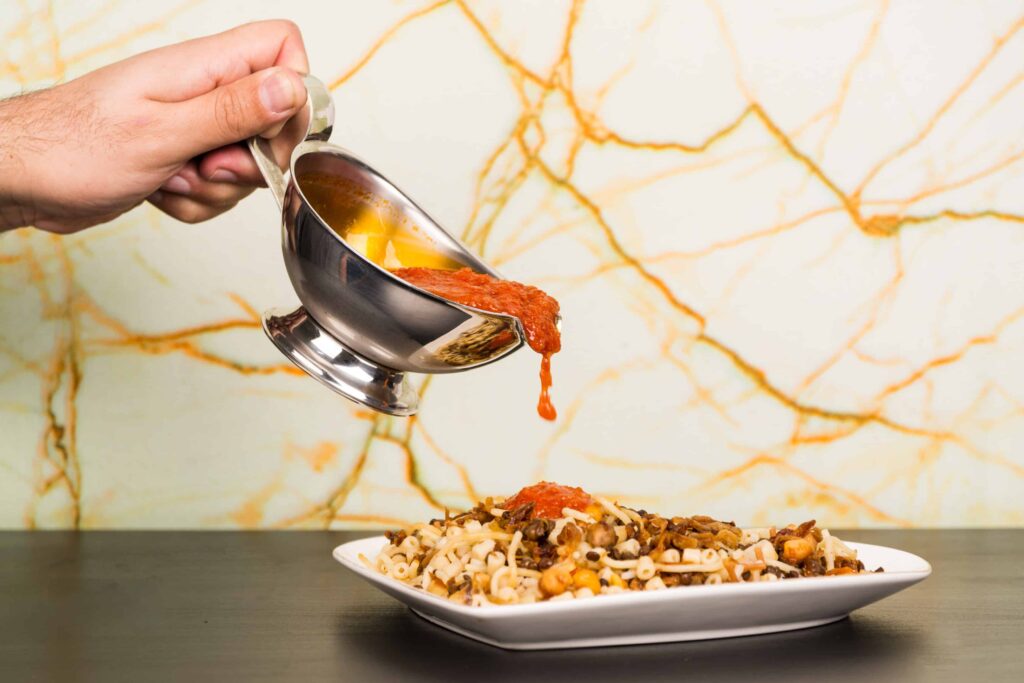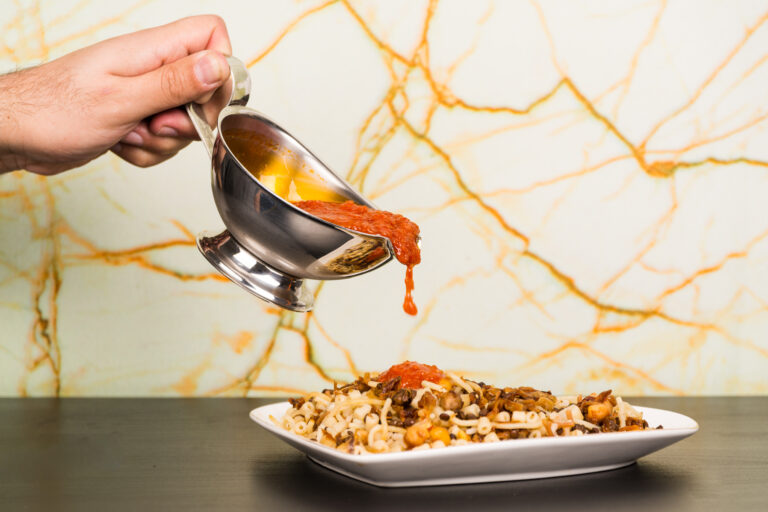Koshari is the national food of Egypt. It’s a flavorful mix of rice, lentils, pasta, chickpeas, and crispy onions topped with a tangy tomato sauce and garlic vinegar. This dish is not just food; it’s an integral part of Egyptian culture and history.
The origins of Koshari trace back to the 19th century during British occupation. The dish was initially popular among the working class due to its affordability and nutritional value. Over time, it gained popularity across all social classes, becoming a staple in Egyptian cuisine.
Our team at Remitly created this guide as part of our series that celebrates the traditional foods of our global customers.
The Origins of Egyptian Koshari
Koshari has roots in both Indian khichdi and Italian pasta. British soldiers brought khichdi to Egypt during colonial times while Italians introduced pasta. Egyptians combined these elements with local ingredients like lentils and chickpeas creating Koshari.
This fusion dish reflects Egypt’s diverse cultural influences over centuries. It’s a testament to how food evolves through migration, trade, and colonization.

Ingredients Used in Egyptian Koshari
The beauty of Koshari lies in its simplicity. Key ingredients include rice, lentils, macaroni or spaghetti, chickpeas, crispy fried onions for garnish along with spicy tomato sauce and garlic vinegar for flavoring.
Each ingredient contributes to the overall taste profile, making it savory yet slightly tangy. Despite its simple ingredients list, preparing Koshari requires careful layering and timing to ensure each component retains its distinct flavor.
Recipe for Egyptian Koshari
Koshari is a simple dish to prepare, but it requires careful timing and layering of ingredients. Here’s a step-by-step guide on how to make this Egyptian classic at home.
Ingredients
- 1 cup rice
- 1 cup lentils
- 1 cup macaroni or spaghetti
- 1 can chickpeas, drained and rinsed
- 2 large onions, thinly sliced
- Vegetable oil for frying onions
- Salt to taste
For the tomato sauce:
- 2 cups canned tomatoes
- 2 cloves garlic, minced
- 1 teaspoon cumin
- Chili powder to taste
For the garlic vinegar:
- 4 cloves garlic, minced
- Half a cup of white vinegar
Instructions
- Start by cooking the rice and lentils together in a pot with salted water until tender.
- In another pot, cook the pasta according to package instructions until al dente.
- Soak chickpeas overnight then simmer until soft.
- For the crispy onions, heat vegetable oil in a pan over medium heat. Add thinly sliced onions and fry until golden brown. Drain on paper towels.
- To make the tomato sauce, sauté minced garlic in olive oil until fragrant. Add canned tomatoes, cumin, chili powder and let it simmer for about 20 minutes.
- For the garlic vinegar, combine minced garlic with white vinegar in a bowl and set aside.
- To serve Koshari: start with a base layer of rice and lentils followed by pasta then chickpeas. Sprinkle crispy onions on top along with generous amounts of tomato sauce and garlic vinegar.
Variations of Koshari Across Egypt
While the basic recipe remains the same, variations of Koshari exist across Egypt. Some regions add vermicelli to the rice while others use different types of pasta like penne or fusilli.
In coastal areas, seafood is sometimes added for an extra layer of flavor. Regardless of these variations, the essence of Koshari—its comforting warmth and satisfying heartiness—remains unchanged.
How Koshari is Served and Eaten
Koshari is traditionally served in a bowl with each ingredient layered on top of another. The dish starts with a base layer of rice and lentils followed by pasta then chickpeas. Crispy onions are sprinkled on top along with generous amounts of tomato sauce and garlic vinegar.
Eating Koshari involves mixing all ingredients together ensuring every spoonful has a bit of everything. It’s often enjoyed as lunch or dinner but can be eaten any time hunger strikes.
Broader Cuisine of Egypt
Egyptian cuisine is as diverse as its history with influences from Mediterranean countries like Greece, Turkey, Lebanon as well as Middle Eastern countries like Saudi Arabia and Yemen.
Staple Foods
Egyptian cuisine is largely based on legumes, vegetables, and grains due to the fertile Nile Valley. Bread, particularly pita bread known as ‘Eish Baladi’, is a staple in every meal. Fava beans are also widely consumed in dishes like Ful Medames and Ta’ameya (Egyptian falafel).
Popular Dishes
Besides Koshari, other popular dishes include Molokhia—a soup made from jute leaves served with rice or bread—and Shawarma—grilled meat wrapped in pita bread. Desserts like Baklava and Basbousa are also well-loved.
Eating Habits
Egyptians typically have three meals a day: breakfast (fatoor), lunch (ghada), and dinner (asha). Lunch is often the main meal of the day where families gather for a hearty feast.
Egyptian Cuisine Abroad
Egyptian cuisine has gained recognition worldwide with restaurants serving authentic Egyptian food popping up in major cities around the globe. From humble street food to elaborate feasts, Egyptian cuisine offers something for everyone’s palate.
Visit the homepage, download our app, or check out our Help Center to get started.
